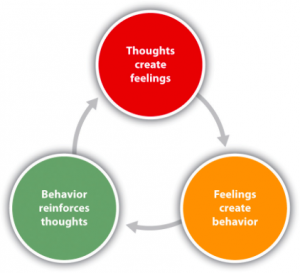My Personal Experience with Cognitive Behavior Therapy
 I’ve had a passion for cognitive behavior therapy (CBT) since the late 1990s when I experienced how broadening my perspective improved my life. I came across CBT in an unusual way. I was attending a four day leadership development seminar. As an introvert, I was struggling in a highly political corporate culture and needed help improving my confidence and relationships at work. Before arriving, I completed a battery of personality tests like the Myers Briggs. On the last day of the seminar, the center brought in a bunch of coaches to help the attendees interpret our results.
I’ve had a passion for cognitive behavior therapy (CBT) since the late 1990s when I experienced how broadening my perspective improved my life. I came across CBT in an unusual way. I was attending a four day leadership development seminar. As an introvert, I was struggling in a highly political corporate culture and needed help improving my confidence and relationships at work. Before arriving, I completed a battery of personality tests like the Myers Briggs. On the last day of the seminar, the center brought in a bunch of coaches to help the attendees interpret our results.
Upon meeting my coach, I admired her presence but thought, “How could she possibly understand me? She looks so confident and at ease in public. She can’t possibly know what it feels like to be nervous to speak up at meetings.” To my surprise, I instantly clicked with her when she shared her experience of being an introvert and how she learned to flex her style to the circumstances. I thought, “If she’s just like me, then there’s hope for me too.” I continued to work with my coach by telephone over the next year and a half.
Fixing My Thinking Traps
My coach listened carefully to how I recounted stories of interactions with colleagues and management. Very early on she said, “I notice you’ve come to a conclusion about what other people are thinking in this situation. You might be right. That’s certainly one conclusion. However, are there any other possibilities of what this situation might mean?” Since my coach approached my beliefs in a supportive and nonjudgmental manner, it melted my resistance and helped me be open to exploring other possibilities.
At first, I didn’t realize that my coach, also a clinical psychologist, was using strategies adapted from cognitive behavior therapy or even what CBT was. She taught me to test my automatic thoughts by identifying all the possibilities of what something might mean and applying percentages to estimate how likely each conclusion was true. I started to see that my initial conclusion might be true but, realistically, it only had about a 30% chance of happening and that there were other logical conclusions I could draw from the same circumstances. I learned to face and plan for my worst fears, like “What if I get fired?” This reduced my anxiety since I no longer thought my “worst case” scenario was 100% true. And, if it did happen, I recognized that I did have the internal resources to cope.
New Perspectives
For example, I might conclude that my manager didn’t value me because she didn’t invite me to a meeting. My coach would say, “Yes, that might be true but are there any others ways to interpret this?” At first this was hard. I’d say, “Well, I really don’t think she values me because a month ago, I didn’t get invited to another meeting.” My coach said, “Okay, but is there any evidence that she does value you?” I thought for a few minutes and said, “Maybe she doesn’t realize I want to be involved with this project because I’ve never shown an interest in it. She probably thinks I’m too busy with all my other work and has decided to take this one on herself. Oh, and now I remember, just last week she gave me a new project and offered to hire a temporary contractor to help me. So I guess she does value me.” The cognitive distortions in my automatic thoughts seem rather obvious now. I was ignoring the positive evidence that my manager valued me and zeroing in on the evidence that supported my negative belief.
Eventually It Becomes More Natural
 Today, the way of thinking I learned from my coach has become more natural and automatic. I’m less likely to jump to conclusions – or when I do – I can stop and ask myself questions to see other possibilities. I continue to actively use CBT skills when I start to feel negative emotions, like worry or anger, in order to manage my mood before it spirals downward. The greatest benefit has been that I feel more engaged in my life and relationships because I’m able to feel subtle positive emotions, like peace and joy. My self-esteem and confidence have increased because I have re-oriented my brain to notice and appreciate the positive, however small it might be.
Today, the way of thinking I learned from my coach has become more natural and automatic. I’m less likely to jump to conclusions – or when I do – I can stop and ask myself questions to see other possibilities. I continue to actively use CBT skills when I start to feel negative emotions, like worry or anger, in order to manage my mood before it spirals downward. The greatest benefit has been that I feel more engaged in my life and relationships because I’m able to feel subtle positive emotions, like peace and joy. My self-esteem and confidence have increased because I have re-oriented my brain to notice and appreciate the positive, however small it might be.
More than a decade later, I am no longer in the corporate world. I went back to school and have become a cognitive behavior therapist, inspired by my personal experience and my desire to help other people find greater peace and joy in their lives.
Note: This article was first published on MentalHelp.net on December 2, 2010.

